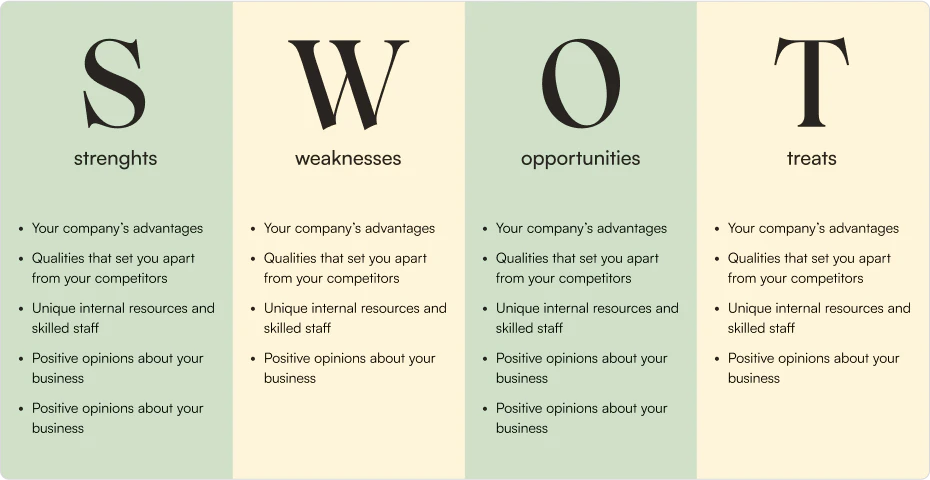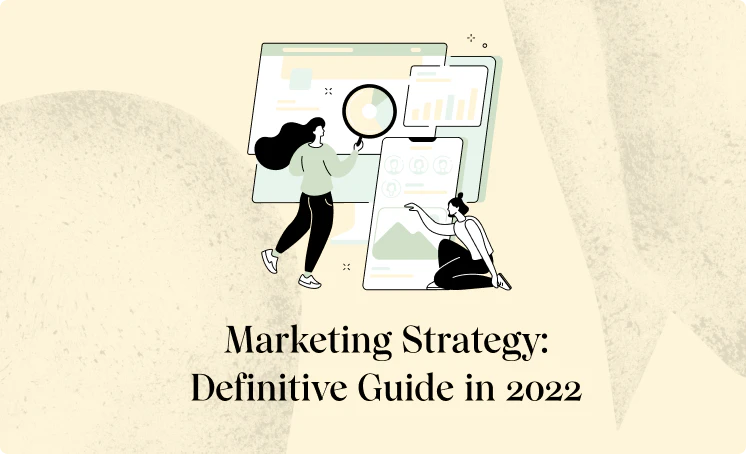Introduction
Being prepared and having a plan to follow is helpful in all areas of life whether you’re building a piece of IKEA furniture, going on a road trip, or deciding the direction of your business.
There are a lot of reasons why certain businesses are more successful but being organized and having clear goals is a sure-fire way to improve your odds and your business.
Your company and clients will not go anywhere if everyone is pulling in different directions. Finding ways to get everyone on the same page can be difficult, but it does not have to be.
With a marketing plan, you can outline your goals, growth, direction, campaigns, and more. With this in mind, we have created below a succinct, universal Marketing Plan Template.
What is a Marketing Plan Template?
There are a wide array of things you can include in a marketing strategy and it can sometimes become convoluted.
Think of a Marketing Plan Template like a map, and each step as a stop on your road to creating a winning and replicable marketing strategy you can use for all your clients or annually for your own business.
Needless to say, every business is unique and will have elements that they may need to add or exclude to best fit their needs.
To ensure an easy and simple-to-follow marketing plan template we have highlighted the core areas that are mostly universal and should apply to businesses of any shape, size, or industry.
Creating a marketing strategy from the ground up can feel like an arduous task, but once you have your initial Marketing Plan Template you will have the grounding for the future and other clients too.
So, in short, developing an effective Marketing Plan Template will stand you in good stead in the long run and thus is worth the effort to create.

Why You Need a Marketing Plan Template
As we touched on in the introduction and previous section, there are a host of reasons to have a marketing strategy template.
Below are just a few examples of why it’s important to implement a template into your marketing strategy.
Have a clear direction
When you have defined your goals and the direction you are heading in it’s much easier to take the steps to start achieving success. Ensuring you have goals that are not too broad is important, just saying ‘I want to grow my business’ is not going to work.
Note: we will take a look at this in more depth a little later with SMART Goals.
Having you, your staff, and your clients all on the same page and working towards the same end goal will automatically make success a lot more achievable.
Understand the strategy
If you do not understand where you need to focus your efforts you will run into several problems. If your marketing is disorganized and ad-hoc you will suffer in the long run.
Knowing what you are doing, where you are going, and where you want to be is half the battle. This is why having a Marketing Plan Template is so critical.
Keeping the tasks front of mind when implementing your plans will lead towards your success and meeting your goals.
However, there will always be unforeseen events that will affect your business or that of your clients. The plan can have a certain level of fluidity to it and should by no means be set in stone.
Ensure you are being consistent
Just because you have finished your marketing plan does not mean you will wake up the next morning and it will be a reality. Any marketer knows that consistency is instrumental to a successful and long-term strategy.
Using a good marketing plan template will help you identify the pieces you will need to put together to form the bigger picture and get the results you want.
When you are consistent with your marketing and business efforts you will gain traction and over time you will pick up speed. Keeping momentum is vital in marketing and understanding when things are working and more importantly understanding when they are not.
Save time
Disorganization is the enemy of success. If you are running around like a headless chicken you are not going to be maximizing your time and resources. This again highlights the importance of working with a Marketing Plan Template that will help reign in your ideas and keep your eyes on the prize.
Knowing what you need to do to start working towards your goals helps you retain focus and save time in both the short and the long term.
How to Create a Marketing Plan Template
Do your research – situational analysis
Before you get formally started with your Marketing Strategy Template you need to gather some research and understand the landscape. You want to know the route before you start your journey.
One of the most common ways to get started is to conduct a SWOT analysis of your business. This is an anagram for its four components, Strengths, Weaknesses, Opportunities, and Threats.
You will need to draft out a list of what your company does well, what you lack, the potential for growth or differentiation, and competitors, etc…
Regardless of how big or small your company is a SWOT analysis is a really helpful and simple tool to highlight different areas of your business and company.
Strengths – Think of the best parts of your company, your USP, your specialization, staff, and both tangible and intangible areas.
Weaknesses – Try to cover as much as you can, areas your competitors are doing better, limitations, anything you are currently missing, shortage of capital/investment, etc…
Opportunities – These can be anything from lack of competitors, areas for growth, media coverage, new markets, new products/services, changing consumer wants and needs, or emerging technology.
Threats – Things that pose a potential risk to your business now or in the future. These could be things that hinder success or growth. Think of competitors, changes in laws, bad PR, financial risks, evolving customer attitudes.

Know your target audience
Once you have done your situational analysis you can move onto the next part of your Marketing Plan, defining your target audience.
Knowing your audience may seem like a fairly rudimentary step but there are a lot of businesses who have not put the time into understanding their buyers.
On the other hand, it is becoming more common for businesses to develop a Buyer Personas. If you already have developed personas for your buyers you can use these as your base.
Buyer Personas are just one of many invaluable tools for a business of any size, which might require a little research to define. Traditionally a buyer persona has a few different parts and serves as a simplification of your types of buyers.
So, what is included in a buyer persona?
- Demographics (Age range, gender, income level, education, job, and even marital status would be examples you might want to include)
- Pain Points (What issues do they have, problems they need solving, solutions they need)
Reasons for Buying (Best price, recommendations, locality, customer service, social proof, etc..) - Buyer Goals (The end result they want)
Developing these personas will give you an idea of your target audience and will help you define how to approach each buyer presented in this research. Having a base understanding of each segment will allow you to set some goals.
Make your goals smart
As we mentioned earlier in the guide, every Marketing Plan Template should include goals and more importantly SMART Goals.
This is making sure you do not just say “I want to get more customers” as your goal, but instead quantify it. With SMART you will know when goals are met, for example, “To increase social media leads by 20% by 2025” would be something you could track and take steps to complete.
Let’s break down what this anagram means – Specific, Measurable, Attainable, Relevant, and Time-Bound. You will find a few variations of the exact terms but the theme is the same regardless, let us explore these in more depth.
SMART Goals – Specific
As we alluded to above, if your goals are too broad then you will never know when they are completed. This is why being specific is so important in goal setting.
This means your goal has to be clearly defined and unambiguous. A good rule to follow is the 5Ws, which should help you narrow down your goal to be much more specific.
- Who will be involved?
- What are we trying to accomplish?
- When do we want to reach this goal?
- Where will this goal be achieved?
- Why is this goal important?
SMART Goals – Measurable
The next part of setting your SMART Goal is having something measurable. When we say this we mean there is some way to track how well it is going or how close you are to succeeding.
Without criteria, you will never know if the goal has been finished. If you have ever heard the idiom ‘how long is a piece of string’ then you know it is important to be specific and realize every situation is different.
With this being said, making your goal measurable can be done using a few different strategies.
- How can I track progress?
- How will I know if I have completed my goal?
- Is there a number/percentage to contextualize progress?
Let us look at an example, your goal might be to increase traffic to your website, but to make it SMART you could set your goal as ‘Increase organic website traffic by 25% in 12 months”.
SMART Goals – Attainable
The basic premise of this is to ensure that you can actually complete your goal, which may feel rather straightforward but a lot of people fail to make goals achievable or attainable.
You will need to ask yourself if you have the ability, staff, resources, and know-how to achieve your goal within a reasonable time frame. If you think you have knowledge gaps or obstacles in the way think of ways to overcome these issues.
Another way you assess how viable your goal is, is to think about if it has been done before? Have your competitors successfully achieved this? Are there other examples of this working?
There is no harm in being aspirational with your goals, just do not be unrealistic and fail to meet them in the future. As with anything, things change and plans may vary, so do not be too strict with yourself.
SMART Goals – Realistic
As we touched on a little above, having a goal that you can actually achieve is incredibly important. Obviously, a goal is something to shoot for, but should always have a good likelihood of success if the proper steps are implemented.
Take for instance if you were playing sport and knew you could not score any points or win, it would seem very pointless, this is the same with your goals.
Think about these points when considering how realistic your goal is.
- Is the goal within reach?
- Are you able to reach it within the time and with your resources?
- Do you have the ability to commit to making the goal a reality?

None your strategy
Now you have a good idea of who your audience is and the kind of goals you want to achieve, you can start looking at the ways you can make them happen.
You will want to deploy some tactics to get you closer to your goals and tailor your marketing strategy to produce results.
To contextualize this, let us say you want to improve your leads generated by social media by 10% within 6 months. You will want to have a few strategies in place to get to this goal.
For example increasing your Facebook ad spend, reworking your adverts, creating a new social media promotion or code, etc…
Needless to say, you need to be realistic with what you can do with the resources you have. Understanding your limitations is incredibly important. So, next we will look at allocating your budget to coincide with your goals.
Define your budget
Although we would all love a limitless budget to create the most extensive marketing plan and garner even more results back, that is unfortunately not the reality.
There is no harm in being creative and thinking of innovative ideas to meet your goals, but you do need to be grounded in the real world.
Before you get too carried away it is best to know what kind of budget you have to work with. A great tip is to jot down the rough amount you think each idea/tactic will cost. Including how long it will take or the assets needed will be invaluable information too.
Once you have a good idea of the budget you can allocate to your marketing plan and achieve your goals you can move onto structuring your marketing plan template.
How to Organize your Marketing Plan Template
Organizing your Marketing Plan Template can sometimes feel like a daunting prospect and a little overwhelming, so here are a few things to consider when planning out your strategy.

LIST YOUR GOALS
These do not always come instantly and might take a little bit of refinement, but you certainly want to have them at the forefront of your final document.
When you are preparing your Marketing Strategy Template ensure these are visible and easy to find when people are reading your plan. This will help set the tone for the rest of the document and help everyone understand the direction it is heading in.
You may have written the best plan ever put to paper, but without the right goals, it will not only be impossible to achieve but hard to get signed off too.
DEFINE YOUR RESEARCH
We will go into what these sections are in greater depth in the next part of this guide, but ensuring your research is easy to find will help create a steady foundation for your strategy.
The research combines internal and external analysis that will become invaluable to not only the successful implementation of the plan but your business moving forward.
This is everything from competitive analysis, SWOT, buyer personas, to secondary research on different ideas and methods to utilize in the pursuit of your plan’s goals.
BREAKDOWN YOUR STRATEGY
Making your strategy digestible and straightforward is imperative. It is unlikely most people will read your whole plan cover to cover, so ensuring there is a good road map to what is included within is key.
Explaining key elements, moves, tactics, and potential results can help readers understand your ideas without them needing to read it all.
This can encompass a lot of different areas from your USP, your goals, branding, marketing channels, aims, and ways to accomplish the desired result.
EXPLAIN YOUR MEASUREMENT METHODS
If you fail to have reasonable methods of measurement, you will struggle to successfully complete your plan, or even get it off the ground.
This section should be done once you have a good idea of your buyers, marketing, and the environment. At this point you should know what you are going to do, now it is just time to define how you will be analyzing it.
Measurement should be done in all facets of the plan and not just at the end. Using correct measurement methods will allow you to keep an eye on how you are doing and if you are likely to hit your goals.
For instance, if you are using a digital marketing-heavy strategy, you will have countless tools at your disposal to monitor and track your data and results.
NOTE YOUR TACTICS
It can sometimes be tough to reach a goal if you do not break it down into different smaller jobs and tasks.
Creating ideas and plans around a handful of tactics will help you come a lot closer to achieving your goals. Think of the goal as the overall objective and the tactics as ways to get closer to that result.
Goals are strategic and are much more long-term, whereas tactics, as the name states, are tactical and more short-term.
Say you are trying to increase website traffic by 40% by 2023, then a tactic might be increasing social traffic to the website, which would add up to the end result.
What Do You Need to Include in a Marketing Plan Template
Although every company will have slightly different things they need to include in their marketing plans, there is a heavy amount of overlap and generalized information that can be included in all plans.
In this section, we are going to look at what you should be including in pretty much every Marketing Plan Template you make.
EXECUTIVE SUMMARY
Ironically despite being first on your marketing plan template, this is best completed last. Your executive summary is just the key points of your full plan.
The executive summary is often used by other staff to scan the document and get a flavor of what the plan entails.
There are a lot of different ways to write an executive summary and certain ways may be better for different organizations. To put it simply, however, this should be no longer than one page of A4 and highlight the core information from the full marketing plan template.
BUSINESS GOALS
Perhaps the most important part of your whole plan is the goals. Once you have conducted your research you should have a good idea of where you want the business to go, and how you can start getting there.
Having clearly defined SMART Goals will allow your whole team to be pulling in the same direction and be quantifiable.
Needless to say, these should be your aims but they are not set in stone. If the situation changes then feel free to address and update these.
It is a good thing to note that your goals should by no means be easy to reach but should be grounded and obtainable. These are goals, not aspirations, do not set yourself up for failure but setting impossible goals.
If you have goals that are not realistic you run the risk of becoming frustrated, lose motivation, and create unnecessary stress for you and your teams.
To summarize, here are a few tips to help you set your goals:
- Set realistic and attainable goals
- Make them challenging but not impossible
- Try not to pick too many, aim for 2 core goals along with a few smaller ones
- Understand things may change so be flexible
- Review your goals after a set amount of time to see if you are on track
- Break down the goals into smaller parts to make them feel less daunting
- Be creative and work with your teams for innovative ideas to reach them
TARGET AUDIENCE
This is where you will utilize the information gathered making your Buyer Personas. If you have not already made a few Buyer Personas it is recommended to have these as they can help you strategize and create campaigns centered around different targets.
To summarize Buyer Personas and their role in a Marketing Strategy Template, this is a series of hypothetical customer profiles you create to showcase ideal buyers of your products/services.
The information included is typically demographic along with some additional useful information such as:
- Gender
- Age
- Occupation
- Goals
- Pain Points / Challenges
- Buying Motivation
- Education Level
- Best Channels to Reach Them
TARGET MARKET
When we talk about your target market we are basically breaking down the entire potential buyers of your product or service into smaller groups, or segments. We create these segments to focus marketing efforts on a smaller similar audience.
This saves a lot of time, energy, and resources by not trying to please everyone, which in turn alienates everyone. You want to focus your efforts on each smaller group as a separate entity.
There are four core types of market segmentation that help marketers narrow down an audience.
Demographic – the core characteristics of a group (age, education, marital status, race, religion, gender, job, etc…).
Geographic – defined by the buyer’s location (area, city, region, rural, urban, country, etc…).
Psychographic – elements of the target’s personality and what they are passionate about (personality, lifestyle, hobbies, interests, beliefs, values, morals, etc…).
Behavioral – this is how the buyer acts and their common goals or objectives (interactions with brands, buying habits, spending patterns, factors that affect their purchase, etc…).
In terms of your Marketing Plan Template, you will want to define your market segments and suggest some ideas to market to them specifically.
How you approach each of your different market segments and parts of your target market could vary drastically, or just be subtle changes. Either way, it’s important to know that you should approach different types of customers in unique ways to garner the best results.
BUYER JOURNEY
Once you have a good idea about your buyers and have summarized the information from your research it can be invaluable to document each of the target market buyer’s journeys.
This can be broken down in a few different ways, but one of the most simple is the three stages of The Buyer’s Journey – Awareness, Consideration, and Decision.
Let us quickly define those and then see how you can plan for them.
Awareness – the buyer has a pain point or problem that needs fixing.
Consideration – they start researching ways to solve it (eg. Google searches or talking to friends/colleagues).
Decision – the customer has come to a conclusion and has a shortlist of providers, and will pick one to buy the product from.
You want to think about your target market, how they research, come to conclusions, and finally decide on your business (or don’t).
Each stage offers potential avenues to reach your customers and cement their business. With this in mind, you want to think of ways to engage them at each step of the way. This in essence is their Buyer Journey and how you can improve your plan and in-turn the results.

INTERNAL ANALYSIS – SWOT
A good marketing plan template should always include a form of internal analysis, and one of the best tools to do this is the classic SWOT (Strengths, Weaknesses, Opportunities, and Threats).
A SWOT is a fairly straightforward way of summarizing your business in an easy-to-digest and understand format. This might even give you some ideas of how to move forward with your plan and goals.
For instance, if you know that there is a trend that is becoming more popular then maybe you will focus some effort on developing products or services in that area.
I.e. With the rise of vegetarian and vegan options in the food industry, more and more classic brands are making dietary options to diversify their ranges.
EXTERNAL ANALYSIS – COMPETITORS
Everyone knows the saying ‘knowledge is power and the importance of never underestimating your opponent, this is why you should always conduct a competitor analysis as part of your marketing plan.
It is unlikely that you are in a monopoly and the only company selling or offering something, so, this means your buyers have options and different ways they can fix their problems or fulfill their needs.
As part of your market research it is vital to think about your competition, what they do well, what they could improve on, gaps in the market, and growth potential.
You can decide how in-depth to do a competitor analysis but it is worth including the following:
- Major competitors
- Startups or ‘rising stars’ (new business that might take some market share)
- What each competitor offers
- A few strengths and weaknesses of each competitor
- Their main products/services
- Price point
- Who they are targeting (target markets etc…)
Competitors come under three major types, Direct (similar products/services), Indirect (comparable products but different goals or markets), and Replacement (substitute products, aiming for the same customers).
So it’s good to consider all three of these when defining your competitors and doing your research and analysis.
Obviously, as with any Marketing Strategy Template, you can decide what will work best for your business, but these are a few good guidelines that should set you off on the right track.
MARKET STRATEGY
As the name of this section suggests, this is how your company will approach your marketing and the tactics you will utilize.
The previous research you have done will be invaluable in your marketing plan. You need to think about how you can appeal to the different audiences and customers you have.
You can break down this section into the – Product, Price, Promotion, Place, People, Process, Physical Evidence. Below we will look at how each of these 7Ps affects your market strategy.

7Ps – Product
Despite the name, Product refers to whatever you are selling, so this could be a service, experience, or a tangible product. Basically, this is anything that a customer will buy from you
Ensuring you have something that your customers actually want or need is vital to being successful. Regardless of whether it is or is not something they need, it is your job to convince them to buy it.
Think about what makes what you are selling better than the competition and something potential buyers will part with their money for.
7Ps – Price
Think about how much you sell your product for and if it is competitive compared to other options on the market.
Having a product that has perceived value for money is important. This does not mean it has to be cheap, but your customers can justify the purchase.
Does your price point work with your target markets? For example, if you are trying to sell a high-end product or service to students, it is unlikely to be a viable pricing plan.
In this section, you can also take note of any seasonal discounts, or demographic group discounts (military, senior, student, etc…).
7Ps – Place
Simply put, place is how your customers can access and buy your product or service. To ensure you have the best offering you need to know how your customers typically interact with your business and where they prefer to shop.
This could be from a wholesaler, from a physical shop, an e-commerce site, your website directly, or through third parties.
You need to think about where your customers will be searching for you and your products, how they get their information, and how they prefer to buy.
It is important to note how and where your competitors are selling. Take for instance they have an online store and you do not, then you are limiting your potential customers.
Place is directly impacted by your budget and size, so be realistic when thinking about this part of your marketing plan.
7Ps – Promotion
For Promotion, you want to note how you are planning to advertise and market your product. Are you going to produce content to support your organic traffic? Increase your social media spend? Work on a new PPC campaign?
This is everything that comes under the broad umbrella of advertising, marketing, and sales. Basically, how you communicate with your audience. It is about finding the right person, at the right time, with the right message.
Just because one promotion works for a certain audience or demographic does not automatically mean it will work for another. This is why you need to tailor your promotions to target different people and garner an understanding of what each type of buyer looks for.
7Ps – People
Contrary to what most think when they hear this section name, this is not your customers but your staff, who will make this marketing strategy a reality.
Who within your business needs to be involved to make this marketing plan a reality and meet your goals.
In this section, you will want to break down each department and the people within it, their roles, and how they will be part of the success of this strategy.
Think of this as everyone who will have an impact on the plan’s success, be it people who are indirectly or directly involved in the business-side of your strategy.
You could have the best product in the world, but without the people to help you make it happen, it will be nothing more than a pipe dream. So, it is important that you do not underestimate the role everyone will have in making your business a success.
7Ps – Process
Your Process is what has to happen to get your product from you to the customer. This can be a lot of steps or very simple depending on how your business operates.
For example, if you manufacture your product and sell directly to the customer from your website, you have a very simple process.
So, Process is how you get your product to your customer, this means you need to note delivery methods if you are subscription-based or one-off purchases, if you provide support or aftercare, etc…
Noting all the steps needed to get your product to your customer could help you highlight where issues or inconsistencies are. You want to make sure you are keeping your business cost-effective while simultaneously providing a winning service to your customers.
7Ps – Physical Evidence
The final ‘P’ is Physical Evidence and this is how your customers know your business is legitimate. This can also be referred to as ‘Proof’ and this helps you get new customers, keep old ones, and improve your standing.
This can be anything from your actual products, reviews, photos, location, anything that is quantifiable that adds legitimacy to your business.
Understanding how Physical Evidence plays an integral role in your marketing strategy is important to developing a successful plan.
YOUR UNIQUE SELLING PROPOSITION (USP)
Including this in your marketing plan is a great way to reinforce its significance.
Knowing and understanding your Unique Selling Proposition (USP) is incredibly important to succeeding in your business. This is especially true if there are a lot of competitors in your market.
If you want to maintain and grow your current market position knowing your USP and how to market that to your potential customers is vital.
Your USP should be front and center in your marketing, on your site, in your emails, and in your sales pitch. If you are the only company that offers something, or offers the quickest shipping, or have the best customer service then let everyone know.
When you have a clear and strong USP you can distinguish yourself from competitors and show customers you are the best for the job.
In short, your USP is what makes you different.
DISTRIBUTION PLAN
In this part of the marketing plan, you are going to detail how customers will buy your products or services from you. As the name implies, it is how you distribute the things you are selling.
You need to think about the different parts of your chain, whether it is directly from you or your website, third parties, or via online sellers, etc…
When you have got the main ways customers can buy from you, think about other options of either reaching them or selling in new places.
For example, if you are getting a lot more sales online, maybe it is worth creating a new PPC or organic campaign to further push those numbers up.
Understanding how customers are accessing your products and how they like to buy is vital to a successful marketing plan. You could have the best invention in the world, but if no one can buy it, it is worth nothing.
BUDGET
When we are referring to a marketing plan’s budget we are not looking at how much your products cost or your overheads, this is looking at the budget allocated for the marketing strategy.
Your budget will vary due to a range of different factors from your company size, type of goals, timeframe, and available resources. The budget aims to highlight the amount of money that will be needed to carry out the plan.
Breaking up the budget into sections will help everyone understand what the total figure is needed for. You can do this by giving a rough estimate of how much each thing will need, for example, $100 a day ad spend on Facebook, 1 x $1000 radio ad, etc…
MARKETING CHANNELS
In this section of your marketing plan, you will want to document the different ways you will market your products/services and company. Give a detailed breakdown of each Marketing Channel.
These channels are the places you publish content, spread awareness, gain business and promote your products. There are a lot of different Marketing Channels, below we will look at some common examples.
You will want to outline what channel you are going to use, how you are going to use it, and how you will be tracking or measuring results from there.
Organic – improving your organic traffic is a great idea for a longer-term goal as the results do not always happen overnight.
Utilizing an organic approach will aid your business in the mid-long term. Describe your ideas for improving your organic traffic, if you are stuck you can easily do some research.
Social Media – jot down which ones you intend to use and how you plan on using them. This could include frequency of posts on social ‘x’, advertising on social ‘y’, and increasing engagement on channel ‘z’.
As all of the major social channels have in-build marketing tools and analytics, measuring your success is fairly easy to do.
PPC – allocating budget to your paid marketing is a great way to improve your results. Look at noting down ways areas you want to focus on, whether it’s increasing Facebook ad spend, Google Ads, or other alternatives.
Give a good idea of how much you want to allocate to this but be aware that you may need to tinker with your campaigns to get the best results.
Email – one of the under-appreciated marketing channels still has its place in your strategy. With the rise of email marketing platforms such as Mailchimp, you do not even have to be an expert to put it together.
Setting aside some budget for a monthly email or promotional offers could be a good use of some of your marketing spend.
Content & Website – if you are looking at revamping and improving your web copy, website, and content it is worth mentioning in your marketing plan.
Content is an incredibly popular method, that if done correctly can yield great results. Start your plan by defining the number of updates you want to do. For example website redesign by June 2022 or 4 blogs a month and one lead magnet.
Word of Mouth – harder to quantify and analyze but having a strategy to increase WOM or recommendations is not a bad idea.
An example of this we see a lot is ‘refer a friend’, companies offer incentives for you to recommend their products or services. Another linked example is incentives for reviews left on the site or testimonials.
Events – if you are planning to have some kind of event to coincide with your marketing tactics then you will want to be as detailed as you can here.
Listing out the various costs and potential impact. Events can be instrumental in certain industries for drumming up new business and increasing awareness.
MARKETING COLLATERAL AND MATERIALS
The term collateral can feel a little aggressive if you are not well versed in the marketing sphere, but this basically means any marketing materials you use to promote your business.
These materials can be tangible like brochures, business cards, and leaflets, or intangible like your website or digital assets.
Either way, it is important to document to identify both the marketing materials you have and the ones you need to create or update for your new plan.
You can put together this list in a range of ways, but the very least you need is the asset names, a short description of what it is, and whether they are current or need to be created/updated.
It is definitely recommended that you create some materials for your new campaign that will aid in increasing its effectiveness and reach. Although this can be constrained by your budget, it is definitely something you should factor in.
Successful materials can sometimes be hard to track and analyze their impact, so using a unique link or code might be a way to help you see where results are coming from.
Different people may refer to this as Promotions Strategy, but the term new customer acquisition strategy avoids any confusion with other sections, so works for non-marketers too.
You want to document in this section ways you can reach new customers, or re-engage ones who have grown distant. There are a whole plethora of ways this can be achieved, so, you will have to find the best tactics for your business and target market.
To put this in context, if you have a young target market, using television advertising would not be a good method. Whereas, conversely, if you have an older demographic you are trying to reach it would not be a good idea to produce content for TikTok.
There is no one-size-fits-all strategy for promotions and new customers, but understanding your target audience will help you to know what and where to promote, and how you engage them.
DIGITAL MARKETING STRATEGY
There are very few businesses that have not seen a huge increase in their online traffic and need for a digital presence in the last decade.
So, it is important to have a marketing plan dedicated to your digital and online marketing.
Having an effective online marketing strategy can have a whole host of benefits from gaining new customers, improving your website’s standing, and improving brand loyalty and recognition.
As we alluded to in previous sections, there are a lot of pieces in the digital marketing puzzle, but some of the most important are as follows.
Content & SEO – the rise of content and Search Engine Optimization should not be overlooked. Factoring this into your digital marketing strategy is a good idea, especially if your competitors are not doing it yet.
Social Media Strategy – list down the social channels you are using, ones you want to develop, and ones that are not where you want them to be. Document some different ways you will use each platform to reach your goals.
Paid Strategy – look into which, if any, ways you want to utilize paid marketing and ads to reach new customers, improve loyalty, and traffic. This part of your strategy will be budget and goal-dependent but should be in some parts involved in most plans.
CONVERSION RATE OPTIMIZATION
To put this simply, this is how you turn prospects into customers, leads into buyers, and clicks to conversions. The processes you utilize to convert people into patrons.
Within this part of your marketing strategy, you want to document the ways you convert or ways you could in the future.
In context, this could be working on getting more reviews and testimonials on your sites, which would help improve your sales and persuade some interested parties to buy.
Think about the different ways you could improve conversions and develop this area of your plan.
LOYALTY STRATEGY
A lot of companies understand the importance of customer retention, loyalty, and keeping your paying consumers happy.
In recent years there has been a real push towards subscription-based services, with the boom of giants like Netflix, Spotify, and the various meal delivery subscriptions (HelloFresh, etc…).
These services would not work without customers staying and paying, so they know they have to have good customer service, listen to what they want, and give them new content.
Having benefits for being loyal customers is a great retention strategy, this can come in many forms, from loyalty cards, points, discounts, exclusive products, and newsletters.
In this part of your Marketing Strategy Template, you want to document ways you can keep your customers happy. This will help you spend less energy finding new customers and more time keeping your current ones loyal.
Desired Outcome
Although every company and client will have a different end goal, the desired outcome of your Marketing Strategy Template is to have a base for creating your marketing plans in the future.
Once you have your own version of a Marketing Plan Template you can replicate it each time you need a new one, updating the information that needs to change.
Having a resource like this is invaluable to any business and hopefully will be the building blocks towards more organized and strategic marketing efforts in the future.
Hopefully, this template will have given you the core tools to create something that works for you and your clients. So whether you are a one-person band or a whole orchestra, this plan should help you create winning marketing plans.
Marketing Plan Template Summary
This template should have given you a good idea of what to include in your marketing plan, how to write each section, and their significance. Obviously, every company and client will have different elements that might need to be included or are not as necessary.
This Marketing Plan Template should act as guidelines that help you in creating a strategy that has the core areas covered. Think of it as a Marketing Plan Sample, that gives you the base to work from.
Remember that the plan is not set in stone, things change, priorities might shift, and extraneous variables will inevitably affect your plans in one way or another. The plan will help you be more prepared and able to react to changes in an organized and structured manner.
Having a successful and detailed plan will lay the foundations to achieve your goals in the long-term. It is worth spending a good amount of timing compiling the marketing strategy and the dividends of your hard work will pay off down the line.
Trust your business to a Performance Marketing Agency that will bring you more customers. Click here to get your free marketing plan.













.webp)

.webp)








.webp)










































.webp)






